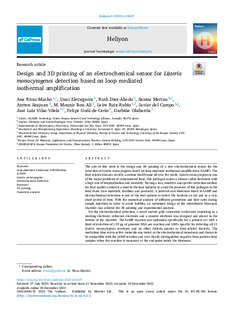Title
Design and 3D printing of an electrochemical sensor for Listeria monocytogenes detection based on loop mediated isothermal amplificationAuthor (from another institution)
Publication Date
2023Other institutions
Basque Research and Technology AllianceTekniker
Universidad del País Vasco/Euskal Herriko Unibertsitatea (UPV/EHU)
Version
Published versionDocument type
Journal ArticleJournal ArticleLanguage
EnglishRights
© 2023 The AuthorsAccess
Open accessPublisher’s version
https://doi.org/10.1016/j.heliyon.2022.e12637Published at
Heliyon Vol. 9. N. 1. N. artículo e12637Publisher
ElsevierKeywords
Loop-mediated isothermal AMPlification (LAMP)
Listeria monocytogenes
Electrochemical detection
Biosensor ... [+]
Listeria monocytogenes
Electrochemical detection
Biosensor ... [+]
Loop-mediated isothermal AMPlification (LAMP)
Listeria monocytogenes
Electrochemical detection
Biosensor
3D printing
Numerical analysis [-]
Listeria monocytogenes
Electrochemical detection
Biosensor
3D printing
Numerical analysis [-]
Abstract
The aim of this work is the design and 3D printing of a new electrochemical sensor for the detection of Listeria monocytogenes based on loop mediated isothermal amplification (LAMP). The food related ... [+]
The aim of this work is the design and 3D printing of a new electrochemical sensor for the detection of Listeria monocytogenes based on loop mediated isothermal amplification (LAMP). The food related diseases involve a serious health issue all over the world. Listeria monocytogenes is one of the major problems of contaminated food, this pathogen causes a disease called listeriosis with a high rate of hospitalization and mortality. Having a fast, sensitive and specific detection method for food quality control is a must in the food industry to avoid the presence of this pathogen in the food chain (raw materials, facilities and products). A point-of-care biosensor based in LAMP and electrochemical detection is one of the best options to detect the bacteria on site and in a very short period of time. With the numerical analysis of different geometries and flow rates during sample injection in order to avoid bubbles, an optimized design of the microfluidic biosensor chamber was selected for 3D-printing and experimental analysis.
For the electrochemical detection, a novel custom gold concentric-3-electrode consisting in a working electrode, reference electrode and a counter electrode was designed and placed in the bottom of the chamber. The LAMP reaction was optimized specifically for a primers set with a limit of detection of 1.25 pg of genomic DNA per reaction and 100% specific for detecting all 12 Listeria monocytogenes serotypes and no other Listeria species or food-related bacteria. The methylene blue redox-active molecule was tested as the electrochemical transducer and shown to be compatible with the LAMP reaction and very clearly distinguished negative from positive food samples when the reaction is measured at the end-point inside the biosensor. [-]
xmlui.dri2xhtml.METS-1.0.item-sponsorship
Gobierno Vasco-Eusko Jaurlaritzaxmlui.dri2xhtml.METS-1.0.item-projectID
info:eu-repo/grantAgreement/GV/Elkartek 2021/KK-2021-00082/CAPV/Microtecnologías como motor de desarrollo de Microsistemas avanzados integrados en la Fábrica Inteligente y Digital en el marco de la IIoT4.0/μ4IIOTCollections
- Articles - Engineering [758]
The following license files are associated with this item:






















